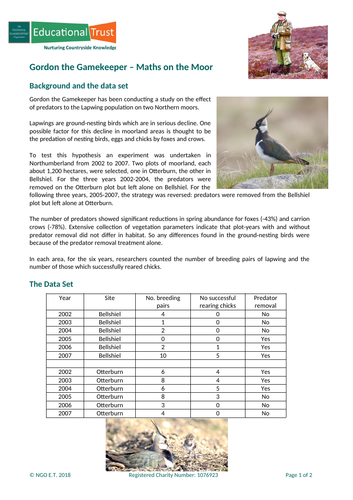


This resource has been created to associate the use of mathematics and statistical principles to real world situations. In this first resource the dataset was realised from a study on the effect of predators to the Lapwing population on two Northern moors.
The target audience for this resource is secondary school level.
Lapwings are ground-nesting birds which are in serious decline. One possible factor for this decline in moorland areas is thought to be the predation of nesting birds, eggs and chicks by foxes and crows. To test this hypothesis an experiment was undertaken in Northumberland from 2002 to 2007. Two plots of moorland, each about 1,200 hectares, were selected, one in Otterburn, the other in Bellshiel. For the three years 2002-2004, the predators were removed on the Otterburn plot but left alone on Bellshiel. For the following three years, 2005-2007, the strategy was reversed: predators were removed from the Bellshiel plot but left alone at Otterburn.
The resource comprises the dataset from the experiment and a series of questions about the dataset which will lead students to conclusions to prove or disprove the hypothesis.
To assist teachers using the resource answers are provided.
NATIONAL CURRICULUM LINKS:
KS4 English: Speaking and Listening
KS4 Maths: Statistics, Graphical representation of data
Something went wrong, please try again later.
Could be a useful context for A level statistics.
Report this resourceto let us know if it violates our terms and conditions.
Our customer service team will review your report and will be in touch.